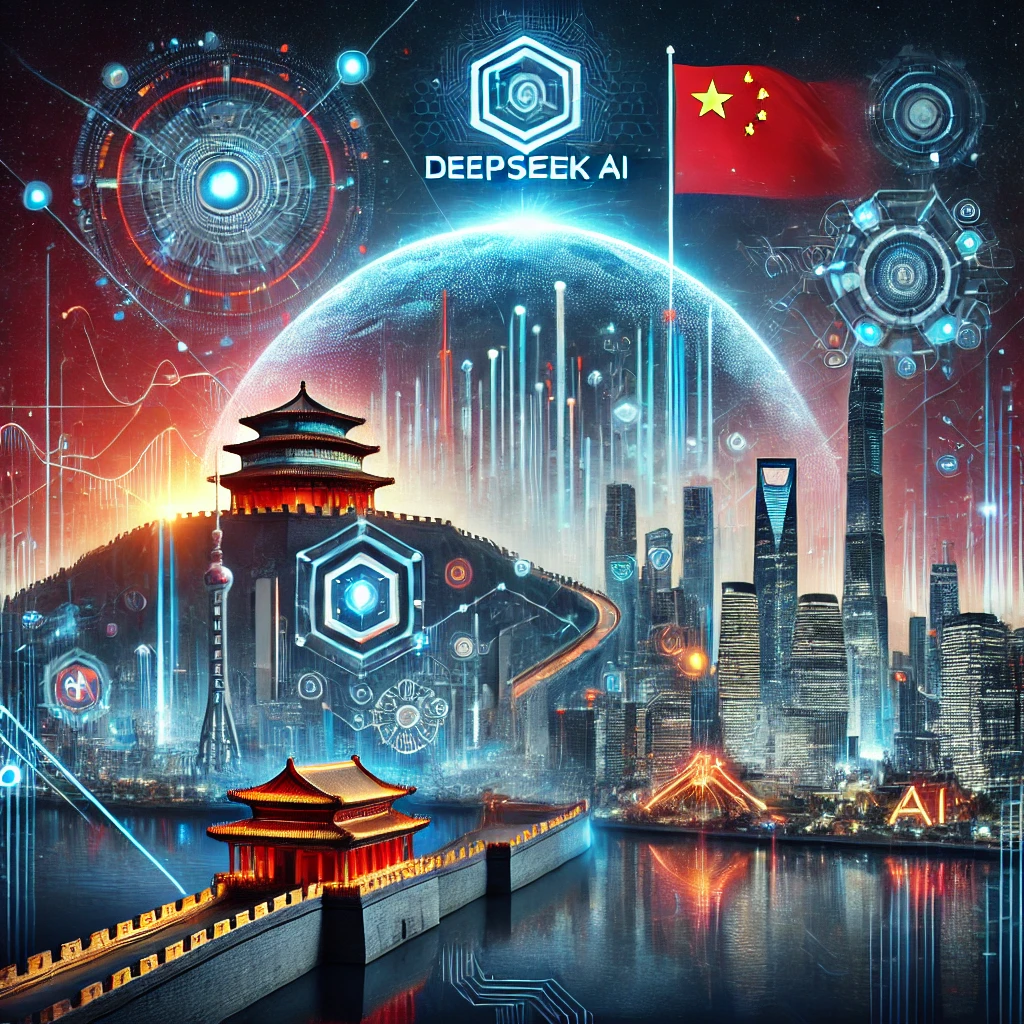The rise of DeepSeek AI, a Chinese AI startup, has shaken the tech world and posed a direct challenge to the dominance of US-based giants like OpenAI and Nvidia. DeepSeek’s breakthrough with its R1 model is not just about creating another chatbot; it’s about reshaping the way artificial intelligence is developed, deployed, and accessed worldwide. As the AI race between China and the US heats up, DeepSeek’s open-source approach and cost-effective model are making waves, forcing industry leaders to reassess the future of AI development.
The Emergence of DeepSeek: A Game-Changer for the AI Industry
DeepSeek’s sudden rise has left Silicon Valley and the wider tech industry stunned. This Chinese startup has disrupted the status quo by launching an AI chatbot that dethroned OpenAI’s ChatGPT on Apple’s App Store, becoming the most downloaded free app in the US. DeepSeek’s R1 reasoning model, released in January, is being hailed as an impressive competitor to existing AI models like GPT-4o and Anthropic’s Claude 3.5 Sonnet.
While ChatGPT has been a darling of AI enthusiasts, DeepSeek’s innovation offers something entirely new—an AI solution that claims to perform at the same level but at a fraction of the cost. This approach has ignited discussions on the future of AI models, especially considering how much money the US tech giants have poured into developing their models. OpenAI, for example, has spent over $100 million just to train GPT-4, a staggering figure compared to the $5.6 million DeepSeek spent on its R1 model.
Cost-Effectiveness: DeepSeek’s Edge Over Major AI Giants
One of the most striking aspects of DeepSeek AI is its ability to produce powerful AI models without the massive financial burden that has been associated with developing cutting-edge AI systems in the US. DeepSeek’s developers claim to have created the R1 model with only 2,000 Nvidia GPUs, a fraction of the 16,000 GPUs that major players like OpenAI and Google use to train their models. This is a game-changer, as it challenges the very foundation of the AI arms race and poses a serious threat to the big tech monopoly that has dominated the space for years.
The significant cost savings achieved by DeepSeek’s team have not gone unnoticed. While US-based companies continue to invest billions into data centers and AI infrastructure, the Chinese startup’s ability to deliver competitive performance at a fraction of the cost has triggered concerns in the financial markets. Nvidia, one of the biggest beneficiaries of AI demand, saw its stock drop over 12% in response to DeepSeek’s arrival on the scene. This sudden shift has led investors and analysts to wonder if the expensive AI infrastructure model is sustainable in the long term.
The Technology Behind DeepSeek’s R1 Model
At the heart of DeepSeek’s success lies its innovative approach to AI model development. The DeepSeek R1 model, built on the V3 large language model (LLM) that was released in December, has already proven to be competitive with top-tier AI systems like GPT-4o. According to the company, the R1 model can solve complex problems and generate human-like responses, similar to other advanced models currently leading the market.
DeepSeek’s open-source AI models are a major part of their strategy. By making these models publicly available, DeepSeek is democratizing AI development, allowing developers around the world to contribute to and improve its AI solutions. This open-source approach not only promotes transparency but also levels the playing field, making AI more accessible to startups, small businesses, and independent developers who can now use cutting-edge technology without the steep costs associated with the development of proprietary AI models.
How DeepSeek’s Open-Source Approach Is Transforming AI Accessibility
Open-source AI has the potential to revolutionize the tech landscape, and DeepSeek is at the forefront of this movement. By offering its models for free, DeepSeek is breaking down barriers that have historically limited access to advanced AI systems. Traditionally, access to AI models has been restricted to large corporations with the financial resources to afford the costly infrastructure required to train these models. DeepSeek’s approach challenges this model by making AI accessible to a broader range of players, from individual developers to small startups.
The open-source nature of DeepSeek’s technology also has significant implications for the AI development ecosystem. It encourages collaboration and innovation, allowing developers to improve upon the existing models and adapt them to their specific needs. This approach has the potential to accelerate the development of new AI technologies and use cases, democratizing AI in a way that hasn’t been seen before.
The Geopolitical and Economic Impact of DeepSeek AI
While DeepSeek’s technological advancements are impressive, its impact on the geopolitical landscape is equally significant. The arrival of DeepSeek AI is part of the larger China vs US AI race, a competition that has escalated in recent years as both countries vie for global dominance in AI. China has long been a major player in AI research, but DeepSeek’s success has raised the stakes, signaling that China is no longer content to be a follower in the AI race.
DeepSeek’s success has placed the spotlight on the limitations of US-led tech policies, especially in regard to trade restrictions and chip manufacturing. DeepSeek has been able to develop its AI models by leveraging open-source software and stockpiling Nvidia’s GPUs, despite the US’s attempts to restrict access to high-powered chips. This raises questions about the sustainability of US policies aimed at maintaining technological superiority in the AI space.
The implications of DeepSeek’s rise are far-reaching. If the Chinese startup can continue to build on its success, it could challenge the dominance of US tech giants like Nvidia, Microsoft, and Google in the AI sector. This shift could lead to a realignment of global power in the tech industry, with China playing an increasingly important role in shaping the future of AI development.
The Future of AI: DeepSeek’s Role in Shaping the Next Generation of AI Models
Looking ahead, DeepSeek’s impact on the future of AI cannot be underestimated. As AI technology continues to evolve, the rise of DeepSeek highlights the possibility of more cost-effective and accessible AI models that could reshape industries across the globe. If DeepSeek can maintain its momentum, it could push the AI industry toward greater innovation and efficiency.
Moreover, DeepSeek’s success in creating high-performing AI models at a fraction of the cost of its competitors could inspire other startups and tech companies to adopt similar strategies. This could lead to a shift away from the expensive, compute-heavy approach that has defined AI development thus far, making AI more sustainable and environmentally friendly in the long run.
The future of AI is uncertain, but one thing is clear: DeepSeek is playing a crucial role in shaping its direction. Whether this will lead to a more democratized AI landscape or spark a new wave of competition remains to be seen. However, DeepSeek’s innovative approach is forcing the industry to rethink how AI can be developed, deployed, and used in the coming years.
Sustainability and Accessibility in AI Development
Sustainability is a growing concern in the AI industry, as the massive energy consumption required to train large AI models has raised environmental concerns. DeepSeek’s approach, which relies on fewer chips and a more cost-efficient model, could offer a more sustainable path for AI development. By reducing the amount of energy required to develop powerful AI models, DeepSeek may help address the environmental impact of AI, allowing the technology to be more accessible and environmentally responsible.
As the AI industry continues to grow, ensuring that AI models are both accessible and sustainable will be crucial. DeepSeek’s innovations suggest that it is possible to create advanced AI technologies without relying on massive financial investments or high energy consumption, paving the way for a more sustainable and equitable future for AI.


